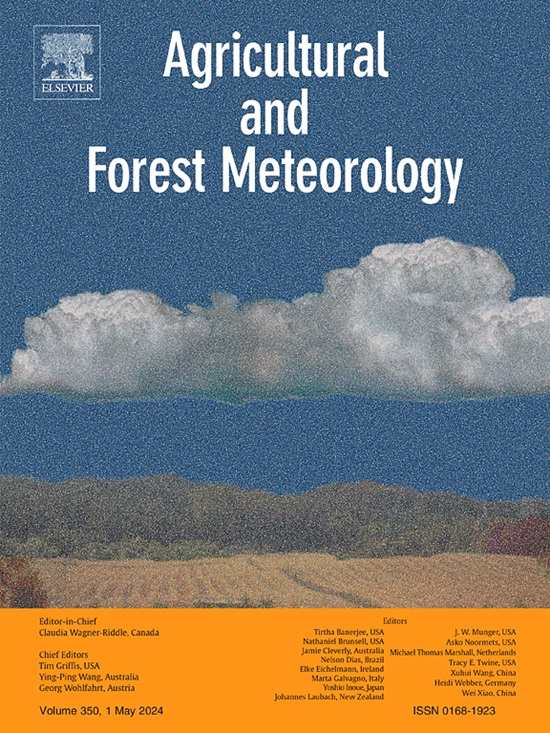Data assimilation of forest status using Sentinel-2 data and a process-based model
IF 5.6
1区 农林科学
Q1 AGRONOMY
引用次数: 0
Abstract
Spatially explicit information of forest status is important for obtaining more accurate predictions of C balance. Spatially explicit predictions of forest characteristics at high resolution can be obtained by Earth Observations (EO), but the accuracy of satellite-based predictions may vary significantly. Modern computational techniques, such as data assimilation (DA), allow us to improve the accuracy of predictions considering measurement uncertainties. The main objective of this work was to develop two DA frameworks that combine repeated satellite measurements (Sentinel-2) and process-based forest model predictions. For the study three tiles of 100 × 100 km2 were considered, in boreal forests. One framework was used to predict forest structural variables and tree species, while the other was used to quantify the site fertility class. The reliability of the frameworks was tested using field measurements. By means of DA we combined model and satellite-based predictions improving the reliability and robustness of forest monitoring. The DA frameworks reduced the uncertainty associated with forest structural variables and mitigated the effects of biased Earth Observation predictions when errors occurred. For one tile, Sentinel-2 prediction for 2019 (s2019) of stem diameter (D) and height (H) was biased, but the errors were reduced by the DA estimation (DA2019). The root mean squared errors were reduced from 5.8 cm (s2019) to 4.5 cm (DA2019) and from 5.1 m (s2019) to 3.3 m (DA2019) for D (sd = 4.33 cm) and H (sd = 3.43 m), respectively. For the site fertility class estimation DA was less effective, because forest growth rate is low in boreal environments; long term analysis might be more informative. We showed here the potential of the DA framework implemented using medium resolution remote sensing data and a process-based forest model. Further testing of the frameworks using more RS-data acquisitions is desirable and the DA process would benefit if the error of satellite-based predictions were reduced.
基于Sentinel-2数据和过程模型的森林状况数据同化
森林状态的空间显式信息对于获得更准确的碳平衡预测至关重要。通过地球观测(EO)可以获得高分辨率森林特征的空间明确预测,但基于卫星的预测的准确性可能会有很大差异。现代计算技术,如数据同化(DA),使我们能够在考虑测量不确定性的情况下提高预测的准确性。这项工作的主要目标是开发两个数据分析框架,将重复卫星测量(Sentinel-2)和基于过程的森林模型预测结合起来。在研究中,在北方森林中考虑了三个100 × 100平方公里的瓦片。一个框架用于预测森林结构变量和树种,另一个框架用于量化立地肥力等级。通过现场实测验证了框架的可靠性。通过数据分析将模型与卫星预测相结合,提高了森林监测的可靠性和鲁棒性。数据分析框架减少了与森林结构变量相关的不确定性,并在发生误差时减轻了对地观测预测偏差的影响。对于一个瓷砖,Sentinel-2对茎直径(D)和高度(H)的2019年(s2019)预测存在偏差,但通过DA估计(DA2019)减小了误差。D (sd = 4.33 cm)和H (sd = 3.43 m)的均方根误差分别从5.8 cm (s2019)降至4.5 cm (DA2019)和5.1 m (s2019)降至3.3 m (DA2019)。对于立地肥力等级估算,DA的效果较差,因为北方森林生长速率较低;长期分析可能会提供更多信息。我们在这里展示了使用中分辨率遥感数据和基于过程的森林模型实现的数据分析框架的潜力。需要使用更多的rs数据采集对框架进行进一步测试,如果基于卫星的预测的误差减少,数据分析过程将受益。
本文章由计算机程序翻译,如有差异,请以英文原文为准。
求助全文
约1分钟内获得全文
求助全文
来源期刊
CiteScore
10.30
自引率
9.70%
发文量
415
审稿时长
69 days
期刊介绍:
Agricultural and Forest Meteorology is an international journal for the publication of original articles and reviews on the inter-relationship between meteorology, agriculture, forestry, and natural ecosystems. Emphasis is on basic and applied scientific research relevant to practical problems in the field of plant and soil sciences, ecology and biogeochemistry as affected by weather as well as climate variability and change. Theoretical models should be tested against experimental data. Articles must appeal to an international audience. Special issues devoted to single topics are also published.
Typical topics include canopy micrometeorology (e.g. canopy radiation transfer, turbulence near the ground, evapotranspiration, energy balance, fluxes of trace gases), micrometeorological instrumentation (e.g., sensors for trace gases, flux measurement instruments, radiation measurement techniques), aerobiology (e.g. the dispersion of pollen, spores, insects and pesticides), biometeorology (e.g. the effect of weather and climate on plant distribution, crop yield, water-use efficiency, and plant phenology), forest-fire/weather interactions, and feedbacks from vegetation to weather and the climate system.

 求助内容:
求助内容: 应助结果提醒方式:
应助结果提醒方式:


